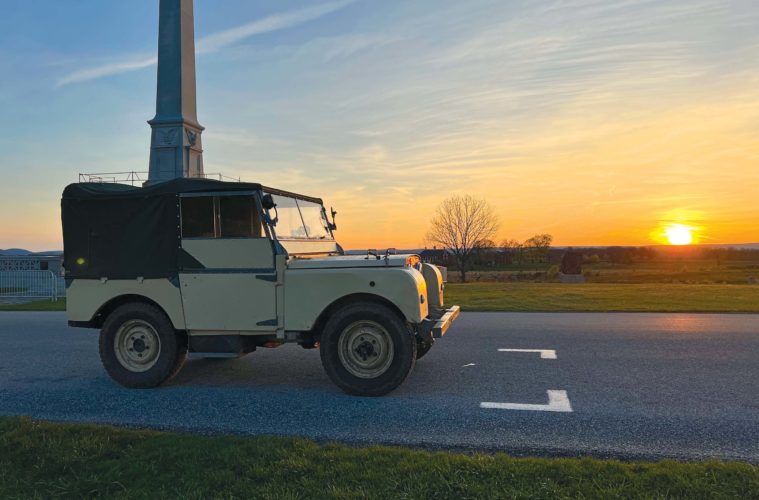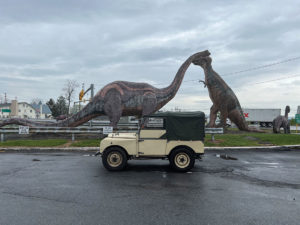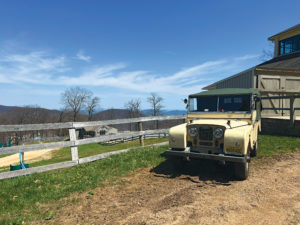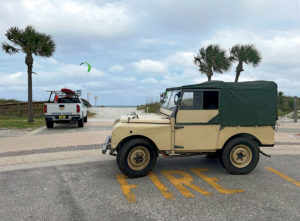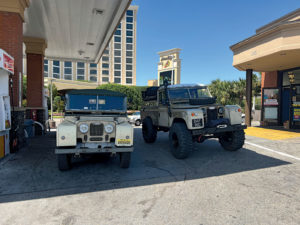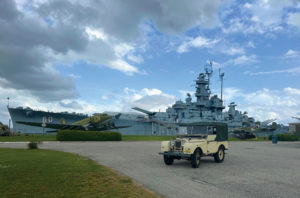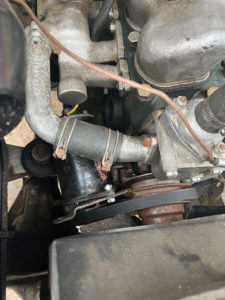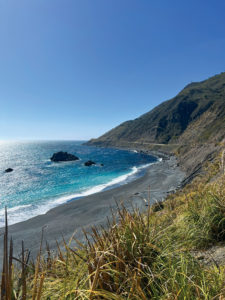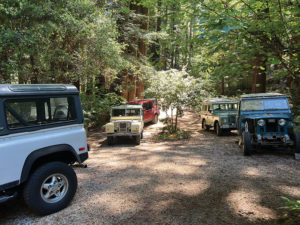The 1950s became the decade in which Land Rovers transported explorers and expeditioners around the world. Some, such as the Oxford–Cambridge First Overland, benefitted from corporate and institutional support, but Australian Barbara Toy purchased a demonstrator 80” Series I on her own and embarked solo on treks that took her around the world.
One tour, captured in her book Columbus Was Right, took Barbara across the USA from San Francisco to New York City. This self-funded venture embodied the qualities that made her travel so special – the “anyone could do this” component. After reading that book (one of five travel books she published), it was all downhill for me. I became determined to make a cross-country Barbara Toy Tribute Tour, in a Series I, traveling – as much as possible – over the same roads. Using Columbus Was Right as a guide, I sourced mid-1950s road maps to determine her most likely route. In some instances, her account provided clear guidance on the roads she chose; in others, I just had to guess.
When Barbara made her crossing, she landed in San Francisco and intended to pass over the Rockies. But her November arrival meant that some mountain passes were already closed due to snowfall. So she took a southern route, driving down to Los Angeles, then crossing the southern states to Jacksonville FL, then north to New York. For logistical reasons, my wife Patty and I decided we would reverse her route.
This just left getting the ’51 Series I ready for a 4,400-mile trip. It required a check of every nut, bolt, and washer, the usual oil seal replacements, the installation of a non-period Fairey overdrive, and conversion from positive to negative ground. “Suzie” is a 71-year-old Land Rover, so a week before the planned departure, the carburetor cracked and the distributor shorted out. Whereas Barbara Toy had stretched her trip over a two-month period, Patty and I had only three weeks available with a looming departure date. So I raided parts from my other Series I 80”. Initially, Patty and I had both planned to travel in “Suzie,” but as we approached the departure date, Patty realized she did not want to be a passenger for three weeks and followed instead in her beloved LR4.
Barbara’s book had few details about her route up the East Coast, so we decided to time our trip with the April ROAV Rovers at Wintergreen event. On a Wednesday morning, “Suzie” led Patty’s LR4 and a friend’s 109” (for a short send-off) from Blairstown, NJ, to Gettysburg, PA. We kept to secondary roads and felt humbled by the spirit of the historic battlefield.
The next morning, we continued south to Virginia. As we drove through Harpers Ferry to make our way to the Shenandoah Valley, the skies opened up with the heaviest rain we experienced during the entire trip. The rain also highlighted the deficiencies in my windscreen seal; a towel sorted the worst of it. As the rain started to clear, we came across a somewhat unexpected sight: two full-size (we presume) dinosaurs. We took this as a signal to stop for a rain break and a leg stretch – both were quite welcome.
From there, we headed to the Wintergreen Resort. I had anticipated we would need to climb the ridge to get up to the event, but I’d failed to realize that coming in from the Shenandoah side meant we would need to climb the Blue Ridge then descend into a valley and climb back up a second ridge. This was not an issue for the LR4, but for the little 1.6L 80” Series I stumbled upon. The best we could manage was 2nd gear up the steep incline, and we basically left it in 2nd gear to control the descent. Fortunately, the people stuck behind us were quite patient about it. This was something we were to encounter throughout the trip – there were only a couple of instances of someone being truly annoyed at our old Land Rover’s complete lack of speed.
Once we arrived, we passed the time greeting well-wishers, showing off “Suzie” and explaining our Tribute Tour to the enthusiastic attendees. [See their interview on Sarek TV’s YouTube channel -ed.]. It was also good to catch up with enthusiasts we’d not seen in some time. We enjoyed the scenery, the brief rest, and the chance to complete a few more tweaks.
After Wintergreen, we made our way south from Virginia, down through the Carolinas to the South Carolina coast. Cruising through the Low Country, we enjoyed the beautiful beaches and marveled at the amazing Live Oaks covered with Spanish Moss. On Georgia’s Jekyll Island, we visited the Sea Turtle rescue and rehabilitation center. Continuing south, we took the two-lane roads to Amelia Island and a bit of the historic A1A in Florida. During this stretch, we started to hear noise from one of the exhaust manifold gaskets, likely a result of laboring up and down the Blue Ridge Mountains. Now, in preparation for the trip, I had thrown spares of almost every imaginable seal and gasket – but, of course, not an exhaust manifold gasket. I snugged in my earplugs and we continued to Jacksonville.
There, we stopped at the point where the old Rte. 90 meets the ocean. When Barbara arrived here in 1957, the local TV station featured her and had her drive onto the beach. When we arrived, we found it was now the site of the local police and beach patrol, with very large signs warning of the fines for driving on the beach. We decided not to try and re-create that part of her trip.
We headed west across the Florida Panhandle as far as Panama City on the Gulf Coast. The closer we got to the city, the more motorcycles we saw on the road. The reason became clear as we entered Panama City with “Welcome Bike Week” signs. My heart sank; I wondered how much trouble we might encounter finding a hotel room. As it turned out, our fears were unfounded and we enjoyed a lovely room overlooking the water.
The next day found us headed toward Mobile, AL, for a meetup with members of the Gulf Coast Land Rover Club, including Charles Bell and Ben Montgomery. We used the parking lot of the USS Alabama Museum as a meeting point, as the ship is rather hard to miss. When a museum staffer, Matthew McCluney (USS Alabama), saw all the Land Rovers in the parking lot, he came out to greet us and let us know that he, too, owned a Land Rover.
Continuing our run on the 90 along the coast, we stopped in Biloxi for the night. The next morning, we met up with another Rover enthusiast, Mickey Slade, who tagged along with us for quite a few miles along the coast in his hybrid Series/Discovery truck. From there, we followed the coast into New Orleans where we decided to do a “Down Day” and take a bit of a break from driving.
It was while driving along Rte. 90 that it really struck to how different things are today from what they were like back in 1957. Back then, many of these roads served as the main roads leading from town to town. But today, with all the modern development, shopping mall entrances, housing projects, and traffic lights clog up the same road. A stretch of road that in 1957 might have taken an hour now requires 2–3 hours behind the wheel.
Patty and I have a fond place in our hearts for New Orleans. As we arrived via Rte. 90, we thought we would stop in City Park for beignets and photo ops. To our surprise, the park grounds were packed and the parking lot was full. Oops – we had arrived during the annual Jazz & Heritage Festival. Advance booking assured us of a comfortable hotel room, and the manager of a favorite French Quarter restaurant made space for “the crazy people driving the vintage car across the country.”
From Barbara Toy’s book, it seemed clear that she had taken Rte. 90 across the state, so we followed in her footsteps, based on her descriptions of the sites and towns she visited. Taking a slight detour up to St. Martinsville, we stopped to see the Evangeline Oak, just as she had done. While crossing western Louisiana and into Texas, the 90 merged in spots into the I-10. We chose to remain in the far right lane so as not to impede traffic.
To make our way to Houston, we followed Barbara’s route and enjoyed a trip aboard the Galveston–Bolivar Ferry. In her book, Barbara describes driving along the shore with the Gulf waters on one side and seeing dozens of oil wells pumping slowly away on the other. As we drove down these back highways, I realized we were seeing the same sites exactly as she had experienced them.
While in Houston, we realized we had a problem – not with the Series I but with our schedule. I had looming work obligations and we had places to see and people to meet. While it wasn’t an easy decision, we decided to keep with the spirit of Barbara’s travels, bypass a couple of stops and rent a trailer to tow “Suzie” with Patty’s LR4. As it happened, the next day “Suzie” made the decision for us.
On the outskirts of Dallas, I heard an odd sound from the engine compartment, followed quickly by an explosion, like I had just driven over a bag of bolts. We pulled off the highway and into an empty lot at the end of an exit ramp. I could see that the generator charge light was on – did I lose the belt? When I opened the hood, I received good news and bad news. The belt looked intact, but the generator now lay on the frame rail. The mounting hardware and bracket had disappeared; only the wires held it in place. A nearby U-Haul depot had car trailers for rent, so one went on the rear of the LR4. We disconnected the generator, taped off the wires, pulled the belt off, and drove “Suzie” onto the trailer. We headed off toward Lubbock and New Mexico.
Enthusiasts Peter and Kim Vollers had moved from Vermont to Placitas, New Mexico, and Peter offered his driveway/carport for the repair. We expected Peter’s hospitality, but not the presence of two Overlanding vehicles – belonging to Mike Ladden of Drive the Globe and Tisha McCombs of Tisha Talks. We were now part of an informal overland festival!
Peter admitted feeling “pangs of remorse,” as he had sold his 80” Series I a few years before. Oil stains on his carport floor provide evidence of my failed efforts at field repairs using Tractor Supply parts. I did manage to cobble together enough bolts to install the generator, but the distance and this delay really set us behind schedule. So “Suzie” would go back on the trailer behind the LR4. (Peter graciously arranged for rooms at Kim’s Los Poblanos Inn in Albuquerque and forwarded the proper parts to us a few days later – a great example of the nationwide Land Rover community at work!)
This turned out to be a good decision, as unusually strong wind storms of 30–50 mph battered the southwest. When we tried to drive south to Albuquerque to rent another trailer, I could not get the Series I above 35mph, the result of high winds and the 6,000 ft altitude. I watched the door tops bending 3–4” out from the roof – eventually, the driver’s side upper hinge failed and broke loose. I used some extra hardware from the generator repair to jury-rig the hinge and bolt it back into place. We picked up another trailer and started moving west again.
Stopping in Holbrook, AZ, we stayed in one of the surviving Wigwam Motels along the old Rte. 66. Barbara found them fascinating enough to include a picture in her book, so this was a must-stop. Nostalgia filled the place: vintage rooms, vintage cars, and huge blocks of petrified wood all around.
The next morning took us west through Winslow and we paid a short visit to Meteor Crater, followed by a longer stay at the Grand Canyon National Park. Dropping “Suzie” off the trailer, we explored the South Rim and followed Barbara’s directions to the El Tovar Hotel. As the hotel sits on the canyon rim, the view was spectacular. Fortunately for our budget, the hotel was fully booked.
We know Barbara visited the Hoover Dam, so the next day we took the road up from Kingman into Nevada. We followed Barbara’s adventures down to the Las Vegas Strip and learned that the California border actually features a border checkpoint – well, an agricultural inspection station. Agents checked every car. When the inspector came up to our window, he looked at me (khaki shirt, sunglasses, battered old hat) and the Series I, and said, “Are you on safari or something?” We continued through the Mojave Desert and into Barstow for the night.
The following day, just outside Barstow, we stopped in the restored ghost town of Calico, where Barbara had encountered the Hemet Cavacaders Jeep club on one of their outings. They were fascinated by her little Land Rover, and one of the club members even took the club badge off the front of his jeep and gave it to her. Barbara’s surviving “Pollyanna” still wears the badge to this day. We then returned to Rte. 66 and headed to friends in Bakersfield (Keith Shukait, Will Shukait, and Brett Gottdener). The parts forwarded by Peter Vollers finally caught up with us, and our friends let us borrow their driveway so I could install the exhaust manifold gaskets and generator mounts.
Heading to the coast, we joined California’s famous Rte. 1 north, one of the most scenic and pleasant drives of the entire trip. We made our way to Monterey for the night and spent the next day visiting the aquarium and touring the peninsula. The following day, we headed up the coast to Felton for the meetup, driving through some impressive fog banks and lovely redwood forests along the way. Eventually, we joined a small convoy of three Series I’s, a IIA, a Defender, and Patty’s LR4 all the way to Half Moon Bay.
Back on our own, we made our way to San Francisco’s Embarcadero, which had been Barbara’s port of arrival. We had made it – 4,400 miles total, 3,100 without the benefit of a trailer. We learned that the road conditions had changed dramatically since 1957, that those conditions challenge a 1.6L 80” Series I, and that squeezing a two-month journey in 1957 into a one-month drive in 2022 was, in all honesty, a mistake.
Next time, we’ll remember what Barbara wrote in her book: “To have to travel fast turns the journey into an endurance test, but with more time, it can be an adventure.”
